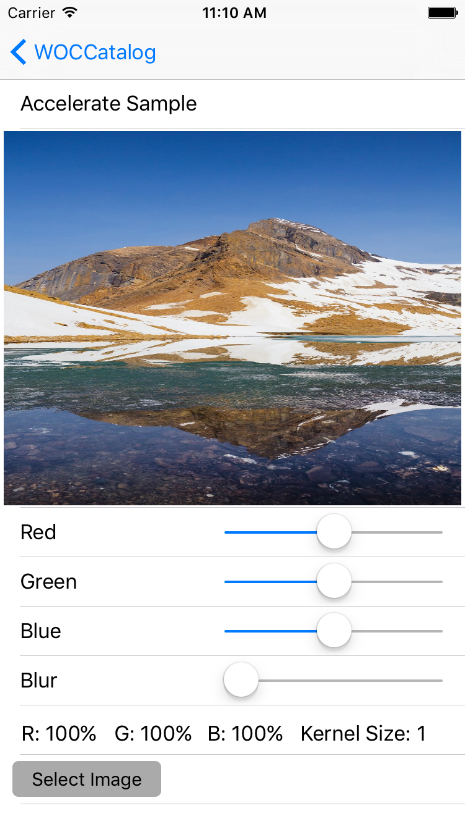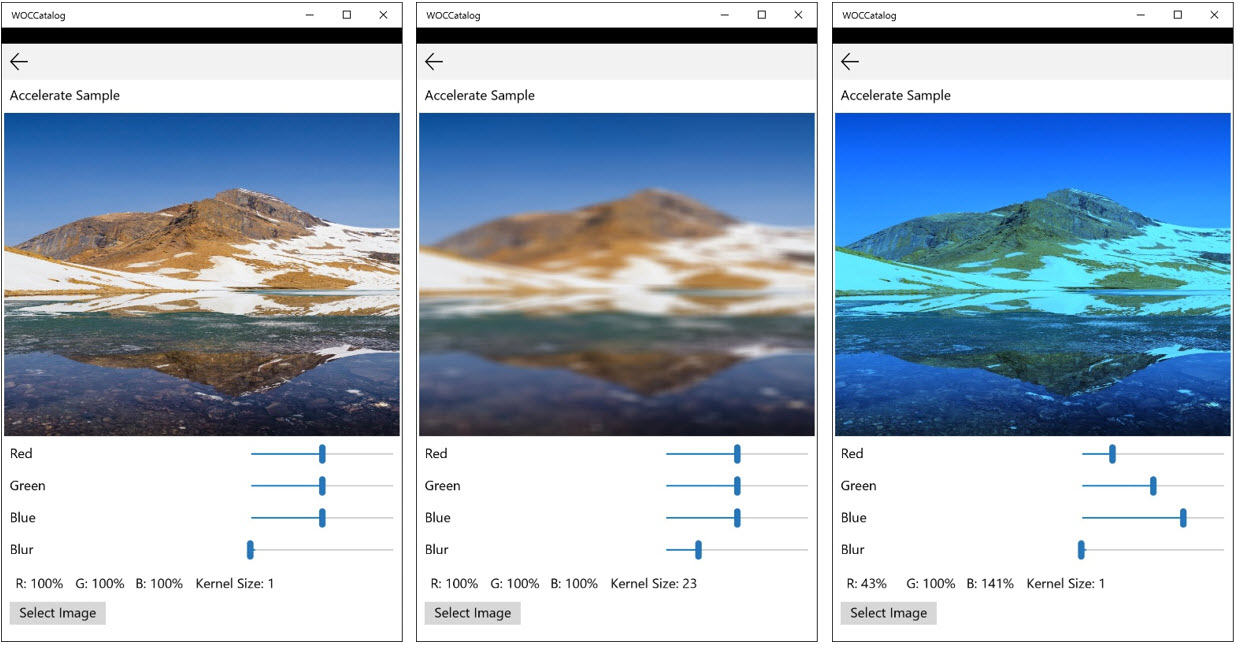Therefore, we are very interested in the Windows Bridge for iOS project and are contributing support for key frameworks used by iOS developers to ensure they perform best on Intel-based Windows 10 devices.
Today, we would like to talk about one of our first contributions to the iOS bridge: the Accelerate framework. The Accelerate framework contains C APIs for vector and matrix mathematics, DSP, and image processing. These APIs are essential for applications with scientific computing needs, including audio and image filters. We have implemented support for BLAS, as well as a subset of the vDSP and vImage APIs. Below is a sample app that uses vImage APIs to modify RGB values and blur an image.
Setting Up the Sample App
To follow along with us, you will need:
- A PC running Windows 10, with Visual Studio 2015 installed. You can download Visual Studio from the Windows Dev Center.
- The latest release of the Windows Bridge for iOS from GitHub.
Running the original app in the iOS simulator results in the following:
You see a default image accompanied by a set of sliders. The Select Image button allows you to select the image that you want to experiment with. The Red, Green and Blue sliders change the RGB values of the image, while the Blur slider allows you to gradually blur it.
If you are curious about running the original iOS app yourself, launch the WOCCatalog.xcodeproj from winobjc/samples/WOCCatalog folder in Xcode on a Mac OS X system, and run the app in the iOS simulator.
Now let’s explore how we can make this app work on Windows 10 using the iOS bridge.
Start by using vsimporter to convert the Xcode project into a Visual Studio solution. To do so, navigate to the winobjc/bin folder on your Windows PC. In a separate Explorer window open up the winobjc/samples/WOCCatalog folder and select File > Open command line prompt to open the command prompt window. Drag the vsimporter file from the winobjc/bin folder into the command prompt window. Once you press Enter, vsimporter will run, and a new Visual Studio solution will be created in the WOCCatalog folder. Open the solution in Visual Studio.
Before we build the app, let’s take a look at the code to get a better understanding of the app’s functionality.
AccelerateViewController.m contains most of the implementation for the app. We start by declaring variables that store Red, Green, and Blue (RGB) values. Then, we declare convolve size variable that controls the blur effect. These are followed by the declaration of UIImageView for displaying the images:
[code language=”csharp”]
int _valueRed;
int _valueGreen;
int _valueBlue;
int _convolveSize;
…
UIImageView* _imv;
[/code]
We then declare UISliders, which allow you to modify the RGB and convolve values, as well as the viewDidLoad method that initializes the sliders:
[code language=”csharp”]
UISlider* _redSlider;
UISlider* _greenSlider;
UISlider* _blueSlider;
UISlider* _convolveSlider;
…
(void)viewDidLoad {
[super viewDidLoad];
_accelerateImageNumber = 1;
_valueRed = 100;
_valueGreen = 100;
_valueBlue = 100;
_convolveSize = 1;
//initialize Red slider:
_redSlider = [[UISlider alloc] initWithFrame:CGRectMake(5.0, 12.0, 180.0, 8.0)];
_redSlider.backgroundColor = [UIColor clearColor];
_redSlider.minimumValue = 0.0;
_redSlider.maximumValue = 200.0;
_redSlider.continuous = YES;
_redSlider.value = 100.0;
…
//load default image:
_img = [UIImage imageNamed:[NSString stringWithFormat:@"photo%d.jpg", _accelerateImageNumber]];
}
[/code]
When you change the position of any of the sliders its corresponding event handler is called. The handlers are similar for all sliders (Red, Green, Blue, and Blur) and contain the following code:
[code language=”csharp”]
// handler function for Red slider:
-(void) redChanged:(UISlider*)slider {
int oldValue = _valueRed;
_valueRed = (int) slider.value;
if (oldValue != _valueRed) {
_indexPathArray = [NSArray arrayWithObject:[NSIndexPath indexPathForRow:1 inSection:0]];
[self.tableView reloadRowsAtIndexPaths:_indexPathArray withRowAnimation:UITableViewRowAnimationNone];
_indexPathArray = [NSArray arrayWithObject:[NSIndexPath indexPathForRow:6 inSection:0]];
[self.tableView reloadRowsAtIndexPaths:_indexPathArray withRowAnimation:UITableViewRowAnimationNone];
}
}
[/code]
These functions in turn call the UITableView method reloadRowsAtIndexPaths:, which refreshes the cells containing the processed image and RGB percentage value labels:
[code language=”csharp”]
(UITableViewCell*)tableView:(UITableView*)tableView cellForRowAtIndexPath:(NSIndexPath*)indexPath {
UITableViewCell* cell = [tableView dequeueReusableCellWithIdentifier:@"MenuCell"];
}
if (indexPath.row == 0) {
// Title cell
cell.textLabel.text = @"Accelerate Sample";
cell.selectionStyle = UITableViewCellSelectionStyleNone;
} else if (indexPath.row == 1) {
// Load transformed/processed image:
[_imv removeFromSuperview];
UIImage* transformImg = [self transformImage:_img];
_imv = [[UIImageView alloc] initWithFrame:CGRectMake(3, 2, cell.bounds.size.width – 6.0f, cell.bounds.size.height – 4.0f)];
_imv.image = transformImg;
[_imv setAutoresizingMask:UIViewAutoresizingFlexibleWidth | UIViewAutoresizingFlexibleHeight];
[cell addSubview:_imv];
cell.selectionStyle = UITableViewCellSelectionStyleNone;
} …
else if (indexPath.row == 6) {
// Update the RGB percentages and Kernel Size value in the UI:
[_rLabel removeFromSuperview];
[_gLabel removeFromSuperview];
[_bLabel removeFromSuperview];
[_boxLabel removeFromSuperview];
_rLabel.text = [NSString stringWithFormat:@"R: %d%%", _valueRed];
_gLabel.text = [NSString stringWithFormat:@"G: %d%%", _valueGreen];
_bLabel.text = [NSString stringWithFormat:@"B: %d%%", _valueBlue];
_boxLabel.text = [NSString stringWithFormat:@"Kernel Size: %d", _convolveSize];
_rLabel.frame = CGRectMake(17.0f, 5.0f, 100.0f, cell.bounds.size.height – 5.0f);
_gLabel.frame = CGRectMake(92.0f, 5.0f, 100.0f, cell.bounds.size.height – 5.0f);
_bLabel.frame = CGRectMake(167.0f, 5.0f, 100.0f, cell.bounds.size.height – 5.0f);
_boxLabel.frame = CGRectMake(242.0f, 5.0f, 200.0f, cell.bounds.size.height – 5.0f);
[_rLabel setAutoresizingMask:UIViewAutoresizingFlexibleHeight];
[_gLabel setAutoresizingMask:UIViewAutoresizingFlexibleHeight];
[_bLabel setAutoresizingMask:UIViewAutoresizingFlexibleHeight];
[_boxLabel setAutoresizingMask:UIViewAutoresizingFlexibleHeight];
[cell addSubview:_rLabel];
[cell addSubview:_gLabel];
[cell addSubview:_bLabel];
[cell addSubview:_boxLabel];
} …
return cell;
}
[/code]
To generate the processed image, the cellForRowAtIndexPath: method calls the transformImage: method, which reads the slider values and applies corresponding changes to the image. The code below shows the section of transformImage where we are calling the Accelerate framework APIs to change the RGB values and blur the image. The Accelerate framework provides the following functions for operating on 8-bit ARGB interleaved images:
- vImageMatrixMultiply_ARGB8888 – this function multiplies each pixel (1×4) with a user-defined 4×4 matrix thus allowing various effects to be applied to the image.
- vImageBoxConvolve_ARGB8888 – this function replaces each pixel with the mean value of its neighboring pixels, therefore blurring the image.
If you are interested in further understanding the capabilities of these functions, you can get more information from Accelerate Framework Reference.
Let’s see how these functions are used in our app. In transformImage we define a 4×4 matrix that stores current RGB values:
[code language=”csharp”]
-(UIImage*)transformImage:(UIImage*)image {
CGImageRef _img = image.CGImage;
vImage_Buffer inBuffer, midBuffer, outBuffer;
vImage_Error error;
void *pixelBuffer, *midPixelBuffer;
…
int16_t A[] = { _valueRed, 0, 0, 0,
0, _valueGreen, 0, 0,
0, 0, _valueBlue, 0,
0, 0, 0, 0};
[/code]
We call the vImageMatrixMultiply_ARGB8888 function to apply the RGB values read from the sliders to the image:
[code language=”csharp”]
error = vImageMatrixMultiply_ARGB8888(&inBuffer, &midBuffer, A, meanDivisor, NULL, NULL, 0);
if (error) {
NSLog(@"error from matrix multiply %ld", error);
}
[/code]
You can play with this function by changing the value of the meanDivisor declared at the very beginning of the file. meanDivisor performs normalization after matrix multiplication is done. The default value is 100. Change it to 50 and see what happens once you build and launch the app.
We then call vImageBoxConvolve_ARGB8888 to blur the image using the edge extension algorithm:
[code language=”csharp”]
Pixel_8888 background;
background[0] = 0;
background[1] = 0;
background[2] = 0;
background[3] = 0;
error = vImageBoxConvolve_ARGB8888(&midBuffer, &outBuffer, NULL, 0, 0, _convolveSize, _convolveSize, background, kvImageEdgeExtend);
if (error) {
NSLog(@"error from convolution %ld", error);
}
[/code]
Building and Running the App in Visual Studio
Now that you have an understanding of the functionality of the app, let’s build and run it. While in Visual Studio, press F5 to run the app and wait for it to finish building. Once the WOCCatalog app launches, scroll to the very bottom and select Accelerate.
By default, you will see an image of a mountain displayed with the Red, Green and Blue sliders set to 100%, and the Blur slider set to 1 (left picture above). Move the Blur slider to the right and observe the change in the image (middle picture). Go ahead and move the Red, Green, and Blue sliders to see what happens (right picture above). You can also select a different image to experiment with by clicking the Select Image button.
Now, let’s modify the code so you can change the RGB values and apply blur to your own image. Before we tweak the code, a couple of things need to be done. First, pick an image you want to play with (e.g. take a picture with your device camera) and put the file into winobjc/samples/WOCCatalog/Images folder. Then, go back to the Visual Studio and in the Solution Explorer right-click the Images folder, select Add –> Existing Item… from the drop down menu and point to your image. In AccelerateViewController.m locate the declaration of array of images (lines 436-445) and modify it as follows:
[code language=”csharp”]
images = [NSArray arrayWithObjects:[[UIImage imageNamed:@"photo1.jpg"] imageWithRenderingMode:UIImageRenderingModeAlwaysOriginal],
[UIImage imageNamed:@"photo2.jpg"],
[UIImage imageNamed:@"photo3.jpg"],
[UIImage imageNamed:@"photo4.jpg"],
[UIImage imageNamed:@"photo5.jpg"],
[UIImage imageNamed:@"photo6.jpg"],
[UIImage imageNamed:@"photo7.gif"],
[UIImage imageNamed:@"photo8.tif"],
// add the name of your image file here, e.g.:
[UIImage imageNamed:@"MyImage.jpg"],
nil];
}
[/code]
Then, locate the viewDidLoad function (described earlier) and change line 101 as follows, so that your image is displayed when the app is launched:
[code language=”csharp”]
_img = [UIImage imageNamed:[NSString stringWithFormat:@"MyImage.jpg"]];
[/code]
Compile and build the app. Once the app launches, go ahead and move the sliders to change the appearance of your image.
Coming Up Next
Today we’ve showed you how you can use Windows Bridge for iOS to make your existing Objective-C code that has Accelerate framework APIs calls work on Windows 10. We encourage you to visit the project’s GitHub page and check out our other contributions: BLAS APIs, Accelerometer APIs, Gyroscope APIs and more. We will continue working together on bringing you additional functionality, so more of your existing Objective-C code can run on Windows. Keep an eye out for our future contributions.
Simonjit Dutta, Engineering Manager, Intel Corporation
Nick Gerard, Program Manager, Microsoft


